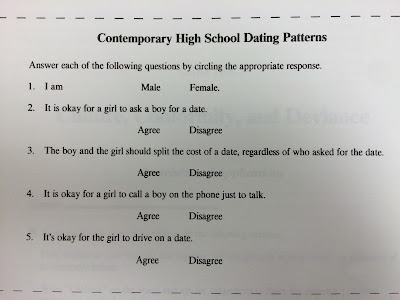2.
What is culture?
The
set of attitudes, values, beliefs, and behaviors shared by a group of people,
but different for each individual, communicated from one generation to the
next.
a. cultural
universals
- A
cultural universal is an element, pattern, trait, or institution that is common
to all human cultures worldwide.
Ex:
clothing/jewelry
religion
music
education
dancing
feasting
sport/recreation
art/entertainment
drug
use
b. material
culture
- material
culture are the physical pieces of culture (artifacts) that you can see, taste,
hear, wear and touch.
Ex:
fashion, clothes, magazines, newspapers, records, CDs, computer games, food,
books, cars, houses and architecture—anything that people make or build.
c. nonmaterial
culture
- Non-material
culture includes the behaviors, actions, ideas, norms, values, and beliefs of a
society - or the way people think.
Ex:
concepts such as good and evil, religion, gestures, rites of passage, table
manners/eating habits, age of consent/adulthood, beliefs in the common good or
individualism, or dating, marriage and mating habits.
d. culture
shock
- Culture
shock is the disorientation a person may feel when experiencing an unfamiliar
way of life due to being in a new culture.
Ex:
tipping
advertisements
eye
contact
food/diet
differences
dating/mating
patters
beliefs
on sex/nudity
beliefs
of time
student-teacher
relationships
5.
Read the following
In
1997, Annette Sorensen, 30, an actress from Copenhagen, Denmark, and Exavier
Wardlaw, 49, a movie production assistant from Brooklyn, NY, were arrested for
leaving their 14-month-old daughter outside a Manhattan restaurant on a chilly
day while they ate inside the restaurant. They left the child in her baby
carriage on the sidewalk. Many passersby called 911 to alert the police. New
York authorities took the child away from her parents and temporarily placed
her in foster care.
In
an ensuing article in the New York Times, one Danish
commentator observed that leaving a baby outside of a restaurant is a very
common practice in Denmark. The commentator wrote, “Often, Danish parents. . .
leave their babies outside. For one thing, Danish baby carriages are enormous.
Babies ride high above the world on horse-carriage-size wheels. It’s hard to
get such a carriage into a cafe. . . . Besides, Danish cafes are very smoky
places.” The commentator continued, “In Denmark, people have an almost
religious conviction that fresh air, preferably cold air, is good for children.
All Danish babies nap outside, even in freezing weather—tucked warmly under
their plump goose-down comforters. . . . In Denmark all children own a sort of
polar survival suit that they wear from October to April and they go out every
day, even in winter.”
A.
What would be an ethnocentric interpretation of the parents’ actions?
ethnocentrism - Ethnocentrism, in
contrast to cultural relativism, is the tendency to look at the world primarily
from the perspective of one's own culture.
B.
What would be a culturally relative interpretation of the parents’ actions?
cultural
relativity
- Cultural
relativism is the idea that all norms, beliefs, and values are dependent on
their cultural context, and should be treated as such.
6.
How does culture influence our daily behavior and social interactions?
a. norms - Social norms are the
explicit or implicit rules specifying what behaviors are acceptable within a
society or group.
Ex:
eye
contact
shaking
hands/hugging
holding
the door open
Greetings:
What's up, How's it going? What's going on? How are you?
Asking
a woman how old she is.
Asking
someone how much money they make.
b. sanctions - a penalty, or some
coercive measure, intended to ensure compliance of social norms, values, etc.
Ex:
legal:
fines/arrest/jail/prison
detention/suspension
social
judgement/isolation
romantic
rejection
employment
problems
c. mores - norms that are widely
observed and have great moral significance. Mores are often seen as taboos; for
example, most societies hold the more that adults not
engage in sexual relations with children. Mores emphasize morality through
right and wrong, and come with heavy consequences if violated.
Ex:
Incest
pre-marital
cohabitation or sex
prostitution
drug
use
racism
d. folkways - norms for more
routine or casual interaction. This includes ideas about appropriate greetings
and proper dress in different situations. In comparison to the morality of
mores, folkways dictate what could be considered either polite or rude
behavior. Their violation does not invite any punishment or sanctions, but may
come with reprimands or warnings. An example to distinguish the two: a man
who does not wear a tie to a formal dinner party may raise eyebrows for
violating folkways; were he to arrive wearing only a tie, he would violate
cultural mores and invite a more serious response.
Ex:
dress
codes
waiting
in line
raising
your hand to speak
"civil
inattention"
personal
space
7.
But not everyone in a society following exactly the same culture. What about
groups that are outside of the dominant or common culture?
a. subculture - A subculture is a
culture shared and actively participated in by a minority of people within a
broader culture.
Ex:
Any
ethnic group (Native Americans, Chinese, Hispanics)
Religious
groups (Jews, LDS/Mormons, Moonies)
Teenagers
Vegans
Farmers
or Cowboys or Coal Miners Tea Party Members
Homosexuals
Goths,
Punks, Geeks, or Trekkers
Knights
of Columbus or Masons
Daughters
of American Revolution
b. counterculture
- Counterculture is a term
describing the values and norms of a cultural group that run counter to those
of the social mainstream of the day.
Ex:
Jihadists
or Nation of Islam
Fundamentalist
Church of LDS (Bigamists) Gangs
PETA
Ku
Klux Klan
Militias
such as Huteree
Hippies
Hells
Angels
Mafia
Neo
Nazis or Skinheads
Soccer
Hooligans (GB)







